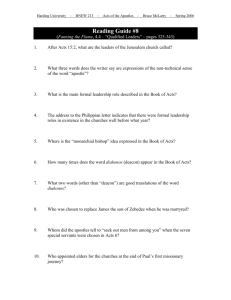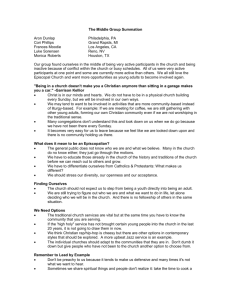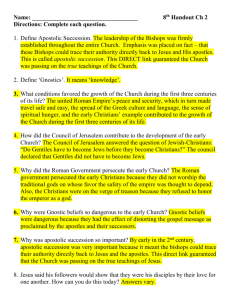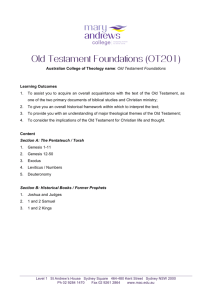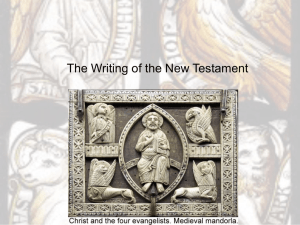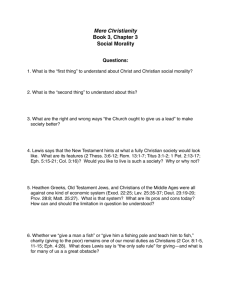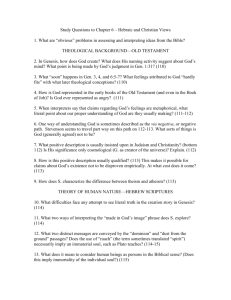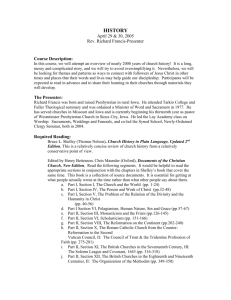PPP - Bama.ua.edu
advertisement
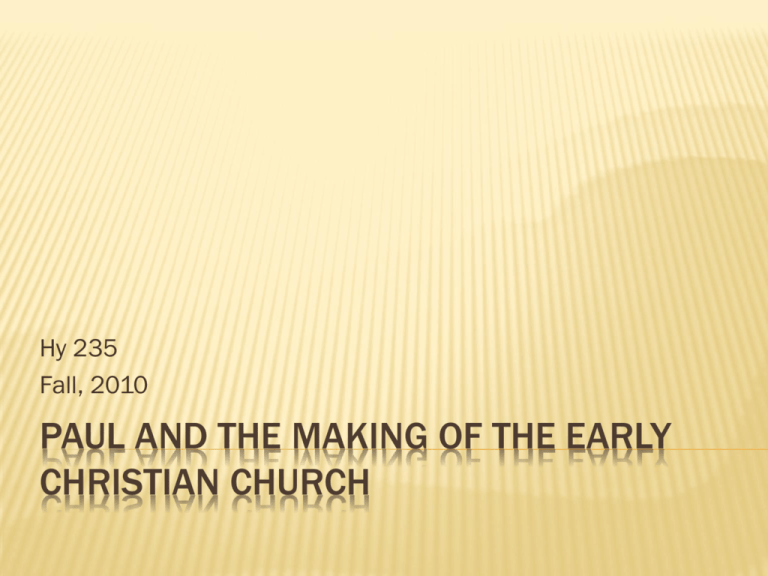
Hy 235 Fall, 2010 PAUL AND THE MAKING OF THE EARLY CHRISTIAN CHURCH St. Paul the Apostle (Hebrew: שאול התרסיŠaʾul HaTarsi, meaning "Saul of Tarsus", Ancient Greek: Σαῦλος Saulos and Παῦλος Paulos[1]), the "Apostle to the Gentiles"[2] was, together with Saint Peter, the most notable of Early Christian missionaries. There is no indication that Paul ever physically met Jesus.[3] Unlike the Twelve Apostles, he came to faith through a vision of the resurrected Jesus[4] and stressed that his apostolic authority was based on his vision. Paul is said to have received the Gospel by "the revelation of Jesus Christ";[5] according to Acts, his conversion took place as he was traveling the road to Damascus. Fourteen epistles in the New Testament are traditionally attributed to Paul, though in some cases the authorship is disputed. Paul had often employed an amanuensis, only occasionally writing himself.[6][7] As a sign of authenticity, the writers of these epistles[8] sometimes employ a passage presented as being in Paul's own handwriting. These epistles were circulated within the Christian community. They were prominent in the first New Testament canon ever proposed (by Marcion), and they were eventually included in the orthodox Christian canon. They are believed to be the earliest-written books of the New Testament. Paul's influence on Christian thinking arguably has been more significant than any other New Testament author.[9] His influence on the main strands of Christian thought has been demonstrable: from St. Augustine of Hippo to the controversies between Gottschalk and Hincmar of Reims; between Thomism and Molinism; Martin Luther, John Calvin and the Arminians; to Jansenism and the Jesuit theologians, and even to the German church of the twentieth century through the writings of the scholar Karl Barth, whose commentary on the Letter to the Romans had a political as well as theological impact. APOSTLE PAUL Paul by El Greco DEAD SEA SCROLLS AND EARLY CHRISTIANITY JUDAISM AND CHRISTIANITY AND THE DEAD SEA SCROLLS The Dead Sea Scrolls include a range of contemporary documents that serve as a window on a turbulent and critical period in the history of Judaism. In addition to the three groups identified by Josephus (Pharisees, Sadducees, and Essenes), Judaism was further divided into numerous religious sects and political parties. With the destruction of the Temple and the commonwealth in 70 C.E., all that came to an end. Only the Judaism of the Pharisees-Rabbinic Judaism--survived. Reflected in Qumran literature is a Judaism in transition: moving from the religion of Israel as described in the Bible to the Judaism of the rabbis as expounded in the Mishnah (a third-century compilation of Jewish laws and customs which forms the basis of modern Jewish practice). The Dead Sea Scrolls, which date back to the events described in the New Testament, have added to our understanding of the Jewish background of Christianity. Scholars have pointed to similarities between beliefs and practices outlined in the Qumran literature and those of early Christians. These parallels include comparable rituals of baptism, communal meals, and property. Most interesting is the parallel organizational structures: the sectarians divided themselves into twelve tribes led by twelve chiefs, similar to the structure of the early Church, with twelve apostles who, according to Jesus, would to sit on twelve thrones to judge the twelve tribes of Israel. Many scholars believe that both the literature of Qumran and the early Christian teachings stem from a common stream within Judaism and do not reflect a direct link between the Qumran community and the early Christians. THE WORLD OF THE SCROLLS In 1947, young Bedouin shepherds, searching for a stray goat in the Judean Desert, entered a long-untouched cave and found jars filled with ancient scrolls. That initial discovery by the Bedouins yielded seven scrolls and began a search that lasted nearly a decade and eventually produced thousands of scroll fragments from eleven caves. During those same years, archaeologists searching for a habitation close to the caves that might help identify the people who deposited the scrolls, excavated the Qumran ruin, a complex of structures located on a barren terrace between the cliffs where the caves are found and the Dead Sea. Within a fairly short time after their discovery, historical, paleographic, and linguistic evidence, as well as carbon-14 dating, established that the scrolls and the Qumran ruin dated from the third century B.C.E. to 68 C.E. They were indeed ancient! Coming from the late Second Temple Period, a time when Jesus of Nazareth lived, they are older than any other surviving manuscripts of the Hebrew Scriptures by almost one thousand years. Since their discovery nearly half a century ago, the scrolls and the identity of the nearby settlement have been the object of great scholarly and public interest, as well as heated debate and controversy. Why were the scrolls hidden in the caves? Who placed them there? Who lived in Qumran? Were its inhabitants responsible for the scrolls and their presence in the caves? Of what significance are the scrolls to Judaism and Christianity? This exhibition presents twelve Dead Sea Scroll fragments and archaeological artifacts courtesy of the Israel Antiquities Authority as well as supplementary materials from the Library of Congress. It is designed to retell the story of the scrolls' discovery; explore their archaeological and historical context; introduce the scrolls themselves; explore the various theories concerning the nature of the Qumran community; and examine some of the challenges facing modern researchers as they struggle to reconstruct the scrolls from the tens of thousands of fragments that remain. OR, THROUGH CHRISTIAN HISTORY.COM The How We Got Our Bible course provides more than an introduction to church history. It helps people ask the key questions Christians have faced over two millennia - and provides answers for those questions for today. Click on the order button below to download this Christian History Study as a Word file. You can choose individual studies or the complete course. You do not have to be a historian or seminary graduate to teach this course successfully. Concepts and events are explained fully, and as a leader you get helpful background material. Plus, each session gives you everything you need--activities, presentation points, discussion starters, and questions. How We Got Our Bible contains at least six weeks of material for your Sunday school class or Bible study - and can be downloaded for your immediate use: Session 1 - Discerning What is Scripture The Bible contains four accounts of Jesus' life, but Christians in the first few centuries knew of at least fifty. Sorting out which books were authoritative was sometimes a controversial process. Session 2 - Jerome and the Latin Vulgate His translation of the Bible into Latin stood for a millennium and set a standard for future translations. Session 3 - The Bible and the Middle Ages During the Middle Ages, art, architecture, and drama brought the stories and truths of Scripture to a non-reading public. Session 4 - John Wycliffe This fourteenth-century English theologian is called the "Morning Star of the Reformation" for his vision to see the church reformed and the Bible translated into the language of the people. Session 5 - William Tyndale Defying the king and the church, Tyndale lived and died to give the Bible to the people. Session 6 - The King James Bible and Modern Translations The nineteenth and twentieth centuries have brought an unprecedented proliferation of English translations of the Bible, but none has made more impact than the King James Version. Conclusion - What the Bible's History Teaches Us Each session begins with a Key Question and a few paragraphs of context. This tells you what the session is about. Next, the Preparation section tells you what is included in each session. Most sessions use articles from the award-winning Christian History magazine--and they're included FREE with your lesson. Other sessions provide a short reading or handouts you can photocopy for the group. The Class Section guides you through the study in four steps - Opening, Historical Setting, Application, and Closing. - Each study lasts between 45 and 70 minutes. - Preparation time may take up to 60 minutes. - Total number of pages for all 6 sessions - 104 - Files can be easily saved, edited, and printed. For questions, e-mail CBSStore@ChristianityToday.com. You have permission to make up to 1,000 copies for use in your local church. 100% GUARANTEE - If you are not completely satisfied with the product you purchase, please e-mail us and we'll provide your next one completely free! THE NICENE CREED The Nicene Creed We believe in one God, father almighty, maker of all things, both visible and invisible. And in one lord, Jesus Christ, the son of God, begotten from the father, only-begotten, that is from the being* of the father, God from God, light from light, true God from True God, begotten not made, one in being** with the father, through whom all things came to be, both those in heaven and those on the earth, who because of us human beings and because of our salvation descended, became enfleshed, became human, suffered and rose on the third day, ascending to the heavens, coming to judge the living and dead. And in the Holy Spirit. The catholic and apostolic Church anathematizes those who say: there was when he was not; and before being born he was not; or that he came to be from things that are not; or that the Son of God is from a different hypostasis or ousia or mutable or changeable. CHRISTIANITY TAKES SHAPE IN FORM AND DOCTRINE (CHAP. 6 OF LATOURETTE) So far as our records enable us to determine, Jesus gave little thought to a continuing organization and did not put the heart of his teaching in any single verbal forumla which was to be binding upon his followers. (p 112). See passage in Matthew about Peter and the church (only mentioned twice in the Gospels). “Thou art Peter, and upon this rock I will build my church, and the gates of hell of hell shall not prevail against it. And I will give unto thee the keys of the kingdom of heaven…” Nothing said about giving Peter authority to transmit the “power of the keys” to a series of successors, whatever else the passage may mean. ORGANIZATION OF THE EARLY CHURCH, PART 1 Great variety in first two or three generations. The ideal was “inclusive unity.” To some extent the church at Jerusalem took the lead, especially on the controversial question of how much should Christians conform to the Jewish law. By the end of the first century, certain organizational features developed, which, in fact have persisted to today offices and officials, including deacons (from the Greek meaning servant or minister), elders (the English translation of the Greek, from which the word presbyter is derived, and from which, in turn, comes the world priest), and bishops (from the Greek meaning something of an overseer or superintendent). Even women may have served as deacons in the early church. Also, apostles , prophets, and teachers are all mentioned in Romans, as well as evangelists, pastors, and exhorters. By the second century, bishops were clearly emerging as the heads of particular churches, and one bishop, of Antioch, presuming to address himself with authority to other churches. As early as first quarter of first century, Bishop Ignatius of Antioch (martyred in Rome under Emperor Trajan, 107 A.D.) was writing of the primacy of the bishops, the need for baptism and the eucharist to be administered by them, or those they delegated, and he also spoke of presbyters and deacons. These were all to be honored and obeyed. Christ had appointed the apostles and the apostles had appointed the bishops and deacons and that was the line of succession and future appointments. ORGANIZATION OF THE EARLY CHURCH, PART 2 THE CHURCH AT ROME Basically, the deference given to Rome as the capital of the Empire was given to the early Christian community in the capital as well. Furthermore, it enjoyed the prestige of the association with both Peter and Paul, although neither was its founder. As early as the third quarter of the second century, Bishop Iraneus of Lyon in Gaul declared that “it is a matter of ncessity that every church should agree with this church [i. e. of Rome] on account of its preminent authority.” [p. 118] THE “GREEK MENACE” Danger to early Christian church was the incorporation of some of the attitudes of the Hellenistic mind. The confidence in philosophy as the way to truth; sometimes explaining the Gospel in categories of Greek philosophy, thus distorting it. Sharp disjunction between spirit and matter, a basic assumption in Hellenism. It molded the thinking and attitude of Christian converts from Hellenistic background. This attitude regarded matter, including the flesh, as evil, and pure spirit as good. Man was a compound of flesh and spirit. “To it, therefore, the goal of every [next page] THE “GREEK MENACE” Man’s striving must be salvation by the emancipation of the spirit from the contamination of the flesh.” (p. 123) “Here was an accounting for the presence of evil, that perennial problem for thoughtful and sensitive souls, which made a great appeal and had sufficient resemblance to the issue presented by the incarnation and the cross to attract many Christians. Again and again we shall find it as a recurring theme in the asceticism, thought, and mysticism of those who have borne the Christian name, among them some of the mosst deoted Christians, men and women who have been esteemed ideal exemplars of the Christian faith.” (ibid.) OTHER HERESIES IN EARLY CHRISTENDOM Gnosticism (pp. 123-125) Marcionites (pp. 125-128) Montanists (pp. 128-129) All these “heresies” forced Christians to develop tighter organization, more clarification and formulation of beliefs. Up until the middle of the first century, all that was required for Christian fellowship was repentance, affirmation that Jesus is Lord, baptism, and reception of the Holy Spirit. The “Catholic” church developed in this era which “soon…embraced the majority of those who thought themselves to be Christians.” (p. 130). EARLY CATHOLIC CHURCH Earliest known use of “Catholic” church in Ignatius’ letter to the church at Smyrna, in early second century. Catholic came to be associated with both the universal and orthodox Church. Three motives for formation of the Catholic Church Desire to unite all Christians in conscious fellowship To preserve, transmit and spread the Christian gospel in its purity. To bring all Christians together into a visible ‘body of Christ.’ (p. 130) The endeavored to this in three ways. Apostolic succession of the episcopate as clear and uninterruped as possible to ensure true transmission of apostolic teachings. Creating and defining the New Testament to pass on the true teachings Defining the Apostle’s creed to ensure orthodoxy APOSTOLIC SUCCESSION, PART I Given impetus by Irenaeus, bishop of Lyons in Gaul, who in his early life (he was a native of either Syria or Asia Minor) had seen Polycarp, Bishop of Smyrna, who had been instructed by the apostles and had talked with many who had seen Christ. (p. 131ff). Irenaeus insisted that “the apostles had transmitted faithfully and accurately what had been taught them by Christ and had not, as the heretics asserted, intermingled with them extraneous ideas. The apostles had appointed as successors bishops who faithfully passed on what Christ had taught. APOSTOLIC SUCCESSION, PART 2 These bishops were followed by others in an unbroken line who were also guardians and guarantors of apostolic teaching. Peter and Paul had established the church at Rome and then appointed Linus and he in turn had been followed by twelve others, all in direct line from Peter and Paul, and Jesus himself. Eusibius, writing in the fourth century and the most famous of early historians of the Church, confirmed the apostolic succession and this became one of the marks of the Catholic Church. Bishops came together in synods to decide on impt. matters, such as declaring certain movements as heresies (the Montanists for example) and expelling them from the Church. Bishops began to emerge not only as administrators, but in charge of the worship and supervised the entire life of the Church. APOSTOLIC SUCCESSION, PART 3 As bishops expanded in number and authority, so did the number of presbyters and priests serving under their authority. Then, as early as the second century, a distinct cleavage began to appear between clergy and laity (p. 133). The clergy took on the semblance of a separate “order,” that designation probably having been derived from the designation given to roman magistrates in a tightly stratified society. Bishops were elected by presbyters and other clergy in the city, ratified by the congregation and approved by other bishops. Presbyters and deacons were selected and ordained by the bishops. Below them were the “minor” orders: sub-deacons, acolytes, exorcists, readers, and janitors. Deaconesses exited in the eastern part of the Empire. APOSTOLIC SUCCESSION, PART 4 But the Bishop of Rome claimed greater authority, and it was natural that the bishops of the larger cities, especially Rome, should be more prominent than those of the smaller cities and towns. THE CANON OF THE NEW TESTAMENT IS DETERMINED, 1 Early on the Jewish scriptures leading them to Christ were read in services. Then, by common usage and consent, books of Christian authority were also brought together. The letters of Paul were read, then the four Gospels, so that by Iraneaus writing in the latter second century spoke of four gospels. Marcion seems to have been the first to assemble Christian writings into a well define collection. This became the genesis of the canon, a collection defined by the test for inclusion: authorship by an apostle or close friend of an apostle. Twenty seven books emerged as the New Testament. Some were accepted readily, others took longer, such as the Revelation of John, a distinctly prophetic book. Books like Hebrews, James, II Peter, and II and III John were early included in some lists; not in others. Some prophets and prophetic literature, especially after the “age of the Apostles” were rejected by the Catholic Church which challenged the administrative regularity represented by the bishops. The first list with all 27 books appears in 367 in a letter by Athanasius, Bishop of Alexandria. Not only did apostolic authorship confirm authority, but “a quality which distinguished them from those books which were rejected, a quality which to the Christian mind was and continues to be evidence of a peculiar degree of divine inspiration, the crown of the process of revelation recorded in the Old Testament.” (p. 135) THE CANON OF THE NEW TESTAMENT IS DETERMINED, 2 FORMATION OF THE NEW TESTAMENT CANON Formation of the New Testament Canon Charts and Documents for this section: The New Testament Canon Disputed Books of the New Testament Ancient Canon Lists Samples of Ancient Heretical Writings Gradual and independent definition of the canon by elders. In the year 367 an influential bishop named Athanasius published a list of books to be read in the churches under his care, which included precisely those books we have in our Bibles (with this exception — he admitted Baruch and omitted Esther in the Old Testament). Other such lists had been published by others, as early as the year 170, although they did not all agree. How did the men who published these lists decide which books should be called Scripture? Scholars who have studied this matter closely have concluded that the lists of books are merely ratifications of the decisions of the majority of churches from earliest days. We are able to prove this by examining the surviving works of Irenaeus (born 130), who lived in days before anyone felt it was necessary to list the approved books. He quotes as Scripture all of the books and only the books that appear in the list published on another continent and sixty years later by Origen. It is evident that the elders of each congregation had approved certain writings and rejected others as they became available, and it turned out, by the grace of God, that most of the churches were by the year 170 in agreement, having approved the same books independently. Prominent teachers were also influential in this process. About that time bishops began to prevail in the Church, as governors of groups of churches, and they simply ratified with these lists the results thus arrived at. The approved books were then called the "canon" of Scripture, "canon" being a Greek word meaning "rod" or "ruler." These books constituted the standard rule of faith for all the churches. We must not imagine that the canon was imposed by ecclesiastical authorities. The canon grew up by many independent decisions of elders who were responsible for their congregations alone. The elders received apostolic writings as authoritative. Then we must ask, how did the elders of the churches decide which writings should be read in church as authoritative? The answer is simple: They received the writings of the apostles and their closest companions, and the writings endorsed by them. The entire Old Testament was received by the implicit endorsement of the apostles. The Gospel of Matthew was written by an apostle. The Gospel of Mark was written by the apostle Peter's closest disciple. The Gospel of Luke was written by the apostle Paul's close companion. The Gospel of John was written by an apostle. The Acts of the Apostles was written by Paul's close companion. Thirteen letters were received from Paul. The epistle to the Hebrews was received as from Paul. The epistle of James comes from the brother of the Lord, who exercised authority in Jerusalem with the apostles. The epistle of Jude was from another brother of the Lord. The two epistles of Peter are from an apostle. The three epistles of John are from an apostle, who also wrote the Revelation. We may ask, How did they know that these writings were not forgeries? The churches did not receive them from strangers. These documents were hand-delivered by friends of the apostles to elders who also knew the apostles personally. Forgeries would be obvious, especially if the writing promoted strange doctrines. Minor disagreements in earliest days. Some disagreements arose along with the rise of heresies. The elders of the churches became wary, and even began to doubt some of the writings they had formerly received as copies from other churches. Writings which came under question were Hebrews, James, Jude, 2 Peter, 2 and 3 John, and the Revelation of John. The reasons for doubt were various. The author of Hebrews does not identify himself. James was not an apostle, and his message seemed to contradict Paul's message. Jude was not an apostle, and he quotes books which the churches did not receive as Scripture. 2 Peter, it seems, was not widely distributed at first. The author of 2 and 3 John does not identify himself plainly. The author of the Revelation identifies himself as John, but does not say that he is the apostle John, and the style of the book is different from the Gospel of John. Nevertheless, the majority of churches received and used these books without questioning them, while vigorously rejecting all others. Universal agreement in modern times. Today we have no good reason for doubting the canon of the New Testament. It would be wrong for me to suggest that everyone needs to investigate these matters and decide for himself which books he will receive as Scripture, without any respect for the decisions of the early churches. We are not in such a position to judge as the early church was, and we are bound to respect the wellnigh unanimous opinion of so many Christians of the past. As Paul says to the Corinthian innovators, "What! Was it from you that the word of God went forth? Or came it unto you alone?" Against such presumption he recommends that which is done "in all the churches of the saints." (14:33b-36). Recently some scholars have tried to promote strange doctrines by suggesting that some of our canonical writings are not genuine, and that other writings such as the Gospel of Thomas are equally valid "interpretations" of the life and teachings of Jesus Christ. I have studied their arguments, and I can assure you that they are not worth listening to. THE APOSTLES’ CREED, 1 The present form probably did not exist before the sixth century. However it had a much earlier origin, probably a primitive baptismal formula, derived from the last chapter of Matthew, “baptizing them in the name of the Father, and of the Son, and of the Holy Ghost.” (p. 135) It was known, with the exception of two or three phrases, as early as the second century to Iraneaus and Tertullian. Not only did it affirm basic Christian beliefs, and was called upon for believers to assent to at baptism, but it rejected certain tenets of various “heresies,” such as the Marcionites (Jesus was but a phantom; flesh is evil, etc.) and others. It was clearly an expression of what was taught by the apostles, amended over time to meet particular challenges as they arose. THE APOSTLES’ CREED, 2 “Moreover, in those few words, “Father, Son, and Holy Ghost,” is succinctly summarized the heart of the Christian Gospel—God Who is Father, Who once in history revealed Himself in one who was at once God and man and Who because of that continues to operate in thelives of men through His Spirit. In this is the uniqueness of Christianity.” (p. 136) I believe in God, the Father Almighty, the Creator of heaven and earth, and in Jesus Christ, His only Son, our Lord: Who was conceived of the Holy Spirit, born of the Virgin Mary, suffered under Pontius Pilate, was crucified, died, and was buried. He descended into hell. [See Calvin] The third day He arose again from the dead. He ascended into heaven and sits at the right hand of God the Father Almighty, whence He shall come to judge the living and the dead. I believe in the Holy Spirit, the holy *catholic church, the communion of saints, the forgiveness of sins, the resurrection of the body, and life everlasting. Amen.
